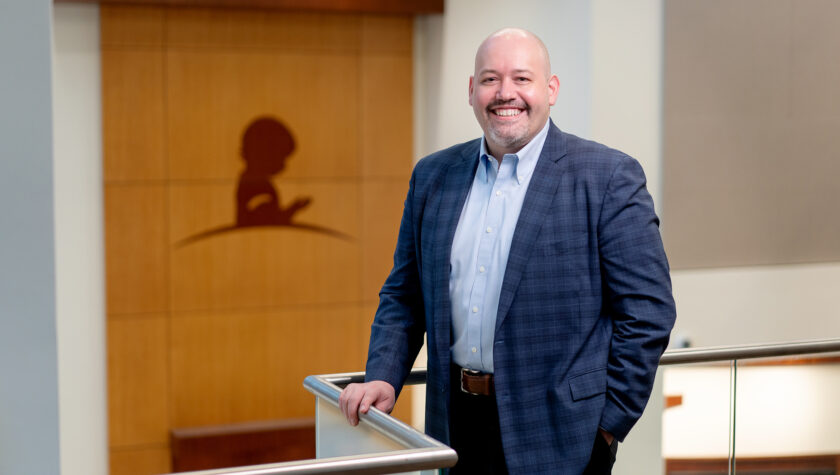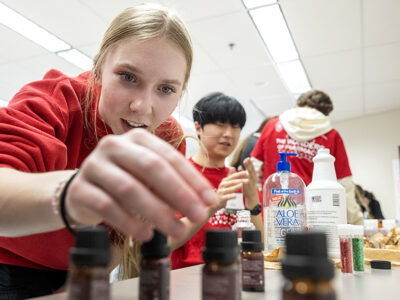
15
September

As senior vice president of quality and safety, alum James Hoffman keeps patients top of mind at St. Jude Children’s Research Hospital
By Katie Ginder-Vogel
“St. Jude is so unique to have such a clear mission: to advance treatment for children with catastrophic diseases,” says James Hoffman (MS ’04). “Everyone buys into that mission; everyone knows why we’re here.”
St. Jude Children’s Research Hospital in Memphis, Tenn., treats about 8,600 pediatric patients with catastrophic diseases each year, and Hoffman is responsible for protecting each one of them as senior vice president of quality and safety. In a leadership role that transcends pharmacy and has impacted innumerable young lives, as well as the lives of patients’ families, Hoffman, who is also a faculty member in Pharmacy and Pharmaceutical Sciences, focuses his research on topics in patient safety and improvement science.
St. Jude, a nonprofit organization that provides free care to its patients, primarily treats cancer, but also conditions like hemophilia, HIV, and, more recently, serious neurological diseases. As a research hospital, many of its patients are involved in clinical trials and cutting-edge treatments that require an exceptional level of oversight.
“I work with other administrators, clinical leadership, and other disciplines to create teams to maintain and improve hospital safety conditions,” he says. “It’s a huge collaborative effort to create structures that ensure patient safety is handled the same way consistently.”
“I’m proud of the things we’ve done to create structure and rally everyone around improving patient care.”
—James Hoffman
Through creating practice models at St. Jude, publishing research, and helping lead the international Clinical Pharmacogenetics Implementation Consortium (CPIC), Hoffman extends his reach beyond Tennessee to advance the efficacy and use of pharmacogenomics as a patient safety strategy.
“We shouldn’t just think of pharmacogenomics as an exciting science, but as a medication safety intervention, and a proactive one at that,” he says. Hoffman helps implement pharmacogenomics as a safety strategy both at St. Jude and through CPIC.
Throughout his laudable career, he’s earned the 2015 Literature Award for Innovation in Pharmacy Practice from the American Society of Health-System Pharmacists (ASHP) Foundation, the 2016 Pinnacle Award from the American Pharmacists Association (APhA) Foundation, and a 2019 ASHP Distinguished Service Award.
“I’m proud of the things we’ve done to create structure and rally everyone around improving patient care,” says Hoffman.
Safety oversight
Hoffman earned his PharmD at the Philadelphia College of Pharmacy, and then came to the University of Wisconsin–Madison School of Pharmacy to earn his master’s degree in health-system pharmacy administration, in conjunction with a two-year residency program at UW Health.
“The program combined a residency and fellowship, and I think that combining practical training with a master’s degree was really a great way to learn,” he says.
Hoffman first joined St. Jude Children’s Hospital in 2004, just after graduating from the School of Pharmacy, and began his career as medication outcomes coordinator.
“I started in a futuristic role at that time as I was designated as the hospital’s medication safety leader,” he says. “At a pediatric hospital with many children who have cancer or complicated diseases, the medication use process is very complex. Over time, I established myself in patient safety and that led to more opportunities beyond medication use.”

For his work with the medication use safety team, Hoffman earned the 2013 St. Jude Clinical Care Improvement Award, and soon after gained oversight of patient safety across the hospital.
“It’s been a great opportunity to think beyond medication use and to the entire hospital and the patients and families we serve,” he says. Starting in 2015, Hoffman was St. Jude’s chief patient safety officer, and in early 2022, he took on more responsibilities as senior vice president of quality and safety.
Hoffman collaborates with other clinicians and colleagues who lead clinical informatics to improve clinical decision support tools at St. Jude. These tools in the health record have not always reached their potential, since they can overwhelm busy clinicians, who may miss important alerts. He has published several papers on improving medication alerts, including a novel method to understand how clinicians interact with alerts and a comprehensive paper on how St. Jude manages common alerts.
At St. Jude, the Department of Pharmacy and Pharmaceutical Sciences is an academic department, and Hoffman is a full faculty member, with research interests spanning topics in patient safety and improvement science, such as how to detect patient safety events, improve patient safety culture, and use clinical decision support systems.
One example of his work in improvement science was guiding St. Jude’s efforts to improve patient handoffs and transitions of care, which was published in Pediatric Quality and Safety. He has also helped define research priorities for pediatric patient safety, demonstrating his academic leadership and drive for improvement science.
“When we do improvement work, sharing information with other hospitals in a formal way, as a publication, has a lot of value,” he says. “It helps us improve patient lives that otherwise would have been out of reach.”
Pharmacogenomics for improved prescribing
Hoffman also works on model practices and clinical practice guidelines to help providers implement pharmacogenomics research into the clinic as part of CPIC and the PG4KDS clinical trial at St. Jude. Through PG4KDS, more than 6,000 St. Jude patients have had pharmacogenomic test results placed in their health records to optimize medication use of 67 medications related to 14 pharmacogenes.
“St. Jude has a long history of discovery work with pharmacogenomics,” Hoffman explains. “I got involved with CPIC and PG4KDS to help that discovery work get into routine practice to improve care.”
“When we do improvement work, sharing information with other hospitals in a formal way, as a publication, has a lot of value. It helps us improve patient lives that otherwise would have been out of reach.”
—James Hoffman
One such gene is NUDT15, which affects how patients metabolize the drug mercaptopurine, which is an essential medication to treat children with leukemia — the important relationship between this gene and how patients’ reaction to mercaptopurine was discovered by Hoffman’s colleagues. Using the results of genomic testing, Hoffman and his colleagues quickly created clinical decision support tools to give prescribers crucial information on patients’ NUDT15 status, improving the safety of mercaptopurine use. In this case, the NUDT15 information is added with information on another gene, TPMT, which was also discovered by St. Jude to change how patients metabolize the drug.
Although he has spent his entire professional career — nearly two decades — within St. Jude Children’s Research Hospital, Hoffman remains invigorated by the ways in which the organization continues to grow and change.
“When I was at UW, if you’d told me I’d be doing the pharmacogenomics work I’m doing now, it wouldn’t have seemed possible,” says Hoffman. “That’s an example of the uniqueness and possibilities of the environment at St. Jude, where we push each day to put our research into practice and improve patient care.”








